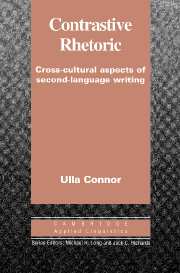Book contents
- Frontmatter
- Contents
- Series editors' preface
- Preface
- I PRELIMINARIES; EARLY PHASES OF THE FIELD
- II INTERFACES WITH OTHER DISCIPLINES
- 4 Contrastive rhetoric and the field of rhetoric and composition
- 5 Contrastive rhetoric and text linguistics
- 6 Writing as an activity embedded in a culture
- 7 Contrastive rhetoric and translation studies
- 8 Genre-specific studies in contrastive rhetoric
- III IMPLICATIONS OF CONTRASTIVE RHETORIC
- References
- Author index
- Subject index
5 - Contrastive rhetoric and text linguistics
Published online by Cambridge University Press: 05 October 2012
- Frontmatter
- Contents
- Series editors' preface
- Preface
- I PRELIMINARIES; EARLY PHASES OF THE FIELD
- II INTERFACES WITH OTHER DISCIPLINES
- 4 Contrastive rhetoric and the field of rhetoric and composition
- 5 Contrastive rhetoric and text linguistics
- 6 Writing as an activity embedded in a culture
- 7 Contrastive rhetoric and translation studies
- 8 Genre-specific studies in contrastive rhetoric
- III IMPLICATIONS OF CONTRASTIVE RHETORIC
- References
- Author index
- Subject index
Summary
Text linguistics is a relatively new development that has greatly affected contrastive analysis. It helped revitalize contrastive rhetoric in the 1980s by providing it with new, valid, and reliable tools for the analysis of texts. This chapter is an introduction to the concepts and methods of text linguistics, and it reviews the most influential research in contrastive rhetoric that has had a text linguistic orientation.
Brief overview of the history of text linguistics; definitions
In the 1970s and 1980s, many linguists felt that traditional morphological and syntactic tools were not adequate to explain texts and that new discourse tools needed to be developed. The resulting new field has been given a variety of names: text linguistics, written discourse analysis, and discourse linguistics. These terms are used almost interchangeably in the literature. (See the discussion of definitions and connotations of the terms in Chapter 2.) However, recent publications treat text linguistics as written, not spoken, discourse analysis – as an analysis of texts that extends beyond the sentence level and considers the communicative constraints of the situation.
Discourse analysis was developed in many countries simultaneously. It appeared in France in the middle of the 1960s. Van Dijk (1985b) describes how, in the United States at the same time, Hymes's Language in Culture and Society (1964) marked the beginning of sociolinguistics, a departure from the transformational grammar of Chomsky, in that it emphasized the social bases of communication and thus was a precursor of discourse analysis.
- Type
- Chapter
- Information
- Contrastive RhetoricCross-Cultural Aspects of Second Language Writing, pp. 80 - 99Publisher: Cambridge University PressPrint publication year: 1996
- 1
- Cited by



